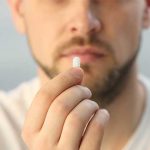Morphine Sulfate Addiction | Abuse Potential, Signs, & Treatment
- Morphine Sulfate Brand Names
- Signs Of Morphine Abuse & Addiction
- Treating Morphine Abuse & Addiction
- Frequently Asked Questions
Morphine sulfate, or morphine, is an opiate drug first isolated from opium in the early 1800s. This powerful painkiller is still widely used in medical care today for both acute and chronic pain.
In fact, morphine is a common choice for moderate to severe pain relief during cancer treatment or treatment for severe accidents, battlefield injuries, heart attacks, kidney stones, or labor and delivery.
As with other strong opioid analgesics, morphine has a high potential for abuse and addiction. Healthcare professionals prescribing morphine should do so with caution.
This high level of risk is reflected in morphine’s classification as a schedule II controlled substance.
Morphine Sulfate Brand Names
Morphine is taken orally, as rectal suppositories, or through intravenous, intramuscular, or subcutaneous injection. As such, there are a variety of different brand name medications containing different formulations of this drug, including two abuse-deterrent formulations:
- a combination of naltrexone and extended-release morphine, or an agonist/antagonist combo that does not generate euphoria if the tablets are crushed for injection
- a tablet including a physical/chemical barrier that makes it much more difficult to break down morphine extended-release tablets for injection
Morphine sulfate brand name medications include:
- AVINza
- Kadian
- Kadian ER
- Morphabond
- MS Contin
- Oramorph SR
- Roxanol
- Roxanol-T
Signs Of Morphine Abuse & Addiction
Recognizing drug addiction, either in yourself or others, can sometimes be a challenge. But there are a variety of different signs and symptoms of addiction, including:
- physical effects of morphine use (constricted pupils, slow or slurred speech, drowsiness, nodding-off)
- increasing time spent using morphine or recovering from morphine use
- increasing morphine dosage or frequency of use
- cravings and intrusive thoughts relating to morphine use
- drug-seeking behavior
- social withdrawal
- inattention
- unstable moods
- sleep problems
- memory problems
- anxiety or depression
- reduced self-care and hygiene
- sexual dysfunction
- constipation
- frequent illness
- financial or legal jeopardy
- inability to feel pleasure from normal, healthy sources
These signs and symptoms of opioid abuse and addiction are generally the same regardless of which opioid is being abused, whether prescription opioids like morphine, oxycodone, or hydromorphone, or illicit opioid drugs like heroin or fentanyl.
Morphine Overdose
Overdose is a significant risk that comes with opioid misuse and addiction.
While a regular dose of morphine poses little risk, modifying morphine medications to increase their effect, increasing your dose, or taking morphine with other drugs (especially benzodiazepines or alcohol) all increase the risk of life-threatening overdose.
Opioid overdose symptoms may include:
- shallow, slow, or irregular breathing (respiratory depression)
- nausea
- slow heartbeat
- blurred vision
- pinpoint pupils
- skin that feels cold to the touch or clammy
- muscle weakness
- drowsiness
- unconsciousness
If you suspect a morphine overdose has occurred, immediately administer naloxone, if available, and call emergency medical services.
Learn more about Morphine Overdose
Treating Morphine Abuse & Addiction
A variety of treatment options have been developed to address opioid addiction, including several prescription drugs approved to help reduce cravings and other opioid withdrawal symptoms.
Medical Detoxification
Long-term use of any opioid drug can result in physical dependence and unpleasant withdrawal symptoms when you stop use.
Acute morphine withdrawal symptoms usually last from three to five days and, though they may be severe, are not life-threatening with medical supervision and detox services.
Short-term withdrawal effects can include nausea/vomiting, increased blood pressure, chills, sleep problems, and agitation.
Learn more about Morphine Withdrawal
Medication-Assisted Treatment (MAT)
Health care providers have access to several medications that can be used to help ease opioid withdrawal symptoms and support recovery treatment. Approved medications for opioid use disorder include:
- buprenorphine, a partial opioid agonist that interferes with other opioids while also decreasing withdrawal symptoms and cravings
- methadone, a powerful long-acting opioid that can block morphine withdrawal symptoms and alleviate cravings without triggering a euphoric high
- naltrexone, an opioid antagonist that blocks the effects of opioids, including their ability to provide pain-relief or euphoria
Inpatient/Outpatient Rehabilitation
After you complete detox, you may be recommended to either inpatient or outpatient addiction treatment depending on your situation and needs. These programs offer treatment interventions that can include:
- cognitive behavioral therapy (CBT)
- motivational enhancement therapy (MET)
- individual counseling
- group counseling
- peer support group participation
- alternative treatments such as animal therapy, exercise therapy, or art therapy
- education and employment coaching
- aftercare support and case management
If you or a loved one struggles with morphine abuse, or any other form of drug abuse or addiction, help is available. Contact Northeast Addictions Treatment Center today to learn how our leading behavioral health and addiction treatment services can best support you and your family.
Frequently Asked Questions
What Are The Different Types Of Morphine?
The different types of morphine include immediate-release (IR) and extended-release (ER) formulations.
Morphine IR has shorter, stronger effects, while morphine ER has weaker, longer-lasting effects. Morphine takes the form of a pill, but may also be given intravenously through a solution called morphine sulfate.
Learn more about the Types Of Morphine
What Does Morphine Look Like?
Morphine, an opioid used to treat severe pain, comes in immediate-release and extended-release versions.
One of the most commonly prescribed forms of morphine is the brand name MS Contin, 30 mg extended-release tablets. The tablets are purple and circular with an imprinting of “M 30” on one side and “PF” on the other.
Learn more about Morphine Identification
How Long Does Morphine Stay In Your System?
Morphine is taken orally or through injection, with oral tablets taking effect in around thirty minutes and injections taking effect almost immediately. These effects then last between 4-6 hours or 2-4 hours, respectively.
Morphine use can be detected in urine tests for up to 3 days after your last dose and in hair tests for as long as 90 days, though hair follicle testing is less reliable.
To learn more, read How Long Does Morphine Stay In Your System?
Is Morphine An Opioid Or Opiate?
Opioid drugs include natural-occurring opiates, semi-synthetic opioids (which are made from opiates), and synthetic (fully man-made) opioids.
Morphine, which is harvested from opium poppies, is an opiate as well as an opioid.
To learn more, read Is Morphine An Opioid Or Opiate?
Is Morphine A Depressant?
Yes, morphine is a depressant. It slows activity in the brain, causing analgesia, sedation, impairment, and other side effects. Abusing morphine may increase the risk of serious side effects.
To learn more, read Is Morphine A Stimulant Or Depressant?
How Is Morphine Classified?
Morphine is classified as an opiate/opioid painkiller and schedule II controlled substance. This means it’s used for treating acute and chronic pain and has a high potential for abuse. It can also lead to psychological and physical dependence.
Learn more about Morphine Drug Classification & Schedule
What Is A Fatal Dose Of Morphine?
A fatal dose of morphine may be as low as 120 mg for morphine pills, and 25 mg for morphine solution. Several factors may affect each person’s risk for overdose.
Learn more about A Lethal Dose Of Morphine
How Is Morphine Produced?
Morphine is produced from opium poppy, a flowering plant grown in Europe and Asia.
Raw opium is collected from the poppy. The various substances inside raw opium, including morphine, are separated out and purified before the drug is then formulated for medical use or converted into the illicit street drug heroin.
Learn more about How Morphine Is Made
How Much Does Morphine Cost?
On the street, morphine usually costs between $10 and $80 per tablet. The exact price depends on the dosage and where you live.
Morphine’s street price is typically much higher than its retail price. The average retail price ranges between $50 and $150, depending on the dosage and pharmacy.
Learn more about Morphine Street Prices & Cost
Can You Take Morphine While Pregnant?
Morphine is a prescription opioid medication and may be safe to take if the pain is severe and does not respond to other treatment methods. However, opioid drugs affect the fetus and increase the risk of brain, spinal, intestinal, and heart defects.
In addition, a baby can be born dependent on opioids and may develop neonatal opioid withdrawal syndrome. Opioid withdrawal in newborns can be severe and may require hospitalization for several weeks.
Sources
- Food and Drug Administration (FDA) — Sponsor Briefing Document: Arymo Er (Morphine Sulfate) Extended-Release Tablet
- National Library of Medicine: MedlinePlus — Morphine
- National Library of Medicine: MedlinePlus — Opioid addiction
- National Library of Medicine: MedlinePlus — Opioid Overdose
- Substance Abuse and Mental Health Services Administration (SAMHSA) — Medications for Opioid Use Disorder
Written by
Northeast Addition Editorial Team
©2024 Northeast Addition Center | All Rights Reserved
This page does not provide medical advice.




